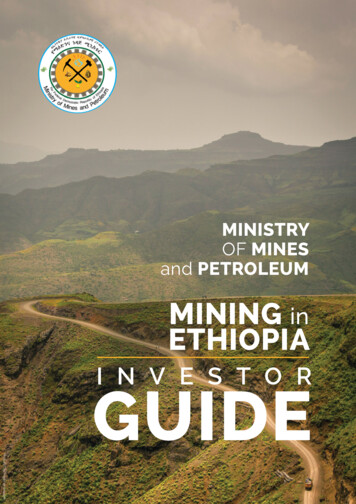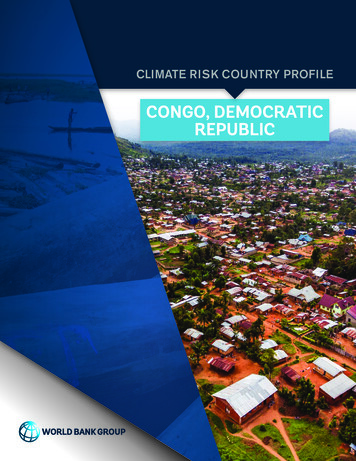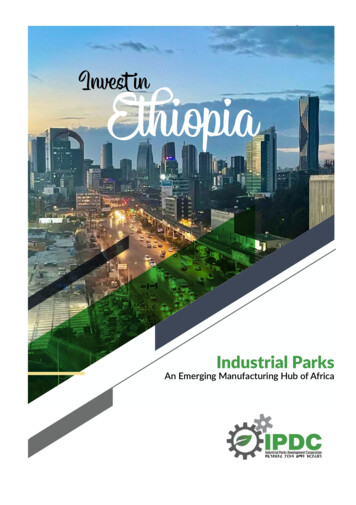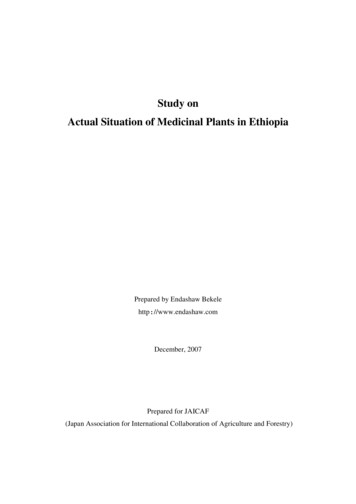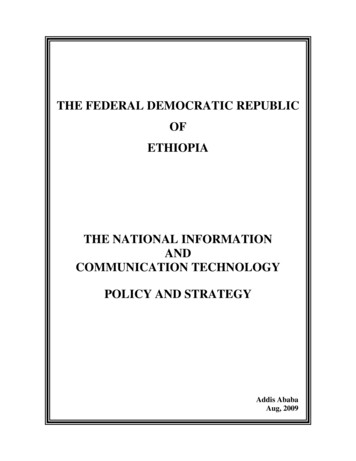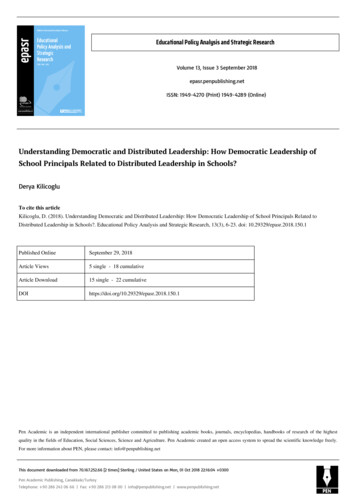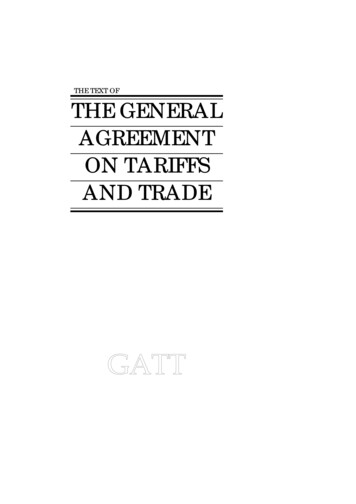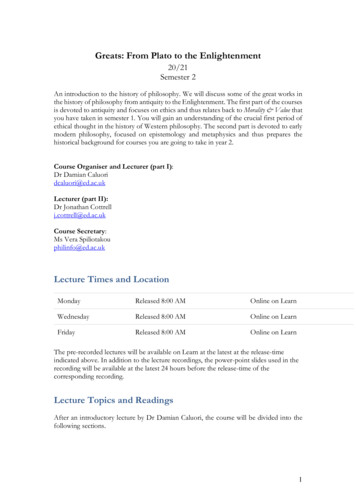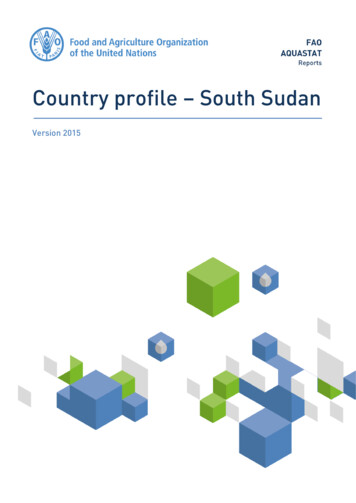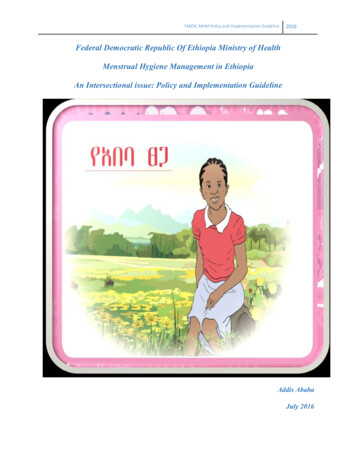
Transcription
FMOH, MHM Policy and Implementation Guideline2016Federal Democratic Republic Of Ethiopia Ministry of HealthMenstrual Hygiene Management in EthiopiaAn Intersectional issue: Policy and Implementation GuidelineAddis AbabaJuly 2016
FMOH, MHM Policy and Implementation GuidelineAcronymsARSHAdolescent Reproductive & Sexual HealthBCCBehavioural Change CommunicationDADevelopment AssistantsFMOHFederal Ministry of HealthFMHACCAFood, Medicine &Health Care Administration & Control AuthorityHDAHealth Development ArmyIPCInformation Provision CentresHEPHealth Extension ProgramHSTPHealth Sector Transformation PlanMDGMillennium Development GoalMHMMenstrual Hygiene ManagementMWIEMinistry of Water, Irrigation and EnergyNRHMNational Rural Health MissionSDGSustainable Development GoalsTSCTotal Sanitation CampaignWASHWater Supply, Sanitation and HygieneWASHCOWater Supply, Sanitation and Hygiene Committees2016
FMOH, MHM Policy and Implementation GuidelineAcknowledgementsThe Federal Democratic Republic of Ethiopia Ministry of Health (FMOH) would like toacknowledge the Hygiene and Environmental Health Case Team under the Health ExtensionProgram and Primary Health Care Service Directorate for initiating this Resource and producingthe guideline.The Federal Democratic Republic of Ethiopia Ministry of Health would also like to thankUNICEF, Water Aid, and SNV for their technical and financial contributions.Last but not least the FMOH would like to forward its thanks to the following individuals fortheir major contributions.1. Dangew Tadesse (FMoH)2. Atsede Kebede (FMoH)3. Mesefin Getachew (FMoH)4. MesereteYetubie (FMoH)5. Selamawit Amare Dr. (FMoH)6. Netsanet Belete (FMoH)7. Selesh Taye (FMoH)8. LidyaSante (Ministry of Education),9. ElhamYesuf(Tiret),10. Kalkidan Gugsa (UNICEF),11. Mekdes Eyuel (UNICEF),12. Kuribachew Mamo (SNV),13. MuluTekie (SNV),14. Selamawit Tamiru (SNV)15. Mahider Tesfu (Water Aid Ethiopia),16. Michale Negash (Water Aid Ethiopia),17. TamiruGetaw (World Vision)18. WoundessonReta (Save the Children)ii
FMOH, MHM Policy and Implementation GuidelineForeword by the State Minister of HealthMenstruation is a natural process in women’s lives. Worldwide 52% of the female population ofreproductive age menstruate every month. However, certain cultural practices aroundmenstruation negatively impact the lives of women and girls and reinforce gender inequalitiesand exclusion. In most parts of the world, menstruation remains taboo and is rarely talked about.It is also considered as a female only topic.Many women and girls do not have appropriate pre and post menstrual hygiene management(MHM) information, access to clean, safe and affordable sanitary products, or private MHMfacilities to change menstrual cloths or pads and to wash. Thus, it affects the daily lives ofmillions of women and girls. It also has various impacts on health and education, which affectthe achievement of girls towards a productive life.MHM intervention needs the involvement of different actors such as health, education, WASH,women and children affairs, private organizations and key influential stakeholders. Thisguideline is developed by the Ministry of Health in close consultation with a range ofstakeholders to initiate and strengthen interventions at different levels by various actors.This guideline document is developed with the objective of creating an enabling environment forsupporting the attainment of GTP II by enabling girls and women in Ethiopia to lead dignified,productive and healthy lives through appropriate menstrual hygiene management. To this end, itis imperative that different government organizations, non-governmental organizations, civilsociety organizations, educational institutions, and the private sector make a coordinated effort inrealizing the implementation of this guideline. Finally, I would like to congratulate all those whotechnically and financially supported the development of this document. I count on your closecollaboration and support to implement the recommendations of this document. The Ministrywill continue its leadership role to realize the implementation of menstrual hygiene managementin Ethiopia.Dr.KebedeWorkuFederal Democratic Republic Of EthiopiaState Minister of Health Program Sectoriii
FMOH, MHM Policy and Implementation GuidelineContentsAcronyms . iAcknowledgements. iiForeword by the State Minister of Health . iiiAbout the guideline . vi1. Introduction and Background . 11.1. Introduction . 11.2. Background . 21.2.1. Global Context: Menstrual Hygiene Management (MHM) . 21.2.2. Ethiopian Context: Menstrual Hygiene Management (MHM). 32. Rationale and Objective . 42.1. Rationale . 42.2. Objectives. 62.3. Target Audience . 62.4. Principles and Approaches . 72.5. Theory of Change . 83. Strategy . 93.1. Context Analysis . 93.1.1. Policy environment . 93.1.2. MHM Relevant sector programs and plans . 93.2. Operational research . 143.3. Communication for Development – The Enabling Environment . 143.3.1. Advocacy . 143.3.2. Social mobilization . 143.3.3. Behavioral Change Communication (BCC) . 153.4. Capacity building . 163.5. Partnership and Coordination. 173.6. Resource allocation and prioritization . 183.7. Ensure Availability of WASH facilities . 184. Minimum Standard Package for MHM . 185. Implementation arrangement for MHM Guideline . 226. Monitoring and evaluation . 296.1 Results Framework for MHM . 30iv
FMOH, MHM Policy and Implementation Guideline6.2 Indicators . 31Bibliography . 32v
FMOH, MHM Policy and Implementation GuidelineAbout the guidelineThis Guide supports organizations working on MHM to encourage all girls and women to adoptsafer menstrual hygiene practices. It also demonstrates how to work with communities andimplement concrete actions for effective menstrual management.The target audience for MHM encompasses behavior change communication audiences referredto as primary participant groups – all women and girls - secondary audiences such as relevanttechnical officials at all levels, and advocacy or tertiary audiences – political leaders.The Guide will be useful for organizations and individuals who are concerned with improvingthe lives of Ethiopian women, girls, men and boys, in the community, in urban and rural areas, inall institutions (particularly in schools and health facilities), at workplaces and in emergencysituations. It will be of particular use to WASH and Education sector professionals, as well asthose working in community development and protection and promotion of rights, includinggender issues. Moreover, the guideline will be useful for decision makers working in governmentoffices, aid agencies, NGOs, influential leaders, teachers and health extension workers who workwith households and communities.Acknowledging the need for further research on the issue of menstrual hygiene management(MHM) in Ethiopia, the authors and contributors of this guideline believe that there is a wealthof in-country experience worth considering. Accordingly, a number of organizations have sharedtheir experiences and international best practices during the process of developing the guideline.The draft document was finalized incorporating further comments and feedback fromparticipants at a validation workshop involving wider stakeholders.The guideline has six sections. Section One provides an overview of menstrual hygiene issues.Section Two explains the rationale for developing the guideline. Strategies for implementingMHM are indicated in Section Three. Section Four suggests a minimum standard package foraddressing menstrual hygiene in a comprehensive manner. Implementation arrangementsvi
FMOH, MHM Policy and Implementation GuidelineIncluding roles and responsibilities of key sector actors are defined in Section Five. The lastsection deals with how to monitor and evaluate the implementation of MHM activities.1. Introduction and Background1.1. IntroductionMenstruation, commonly called a menstrual period, is the monthly discharge of blood from theuterus through the vagina of girls at puberty and non-pregnant and non-menopausal women.Though there is variation in the length of the menstrual cycle and the amount of blood girls andwomen lose, the bleeding usually lasts from about three to seven days and the whole menstrualcycle takes 21 – 35 days with average length of 28 days from the first day of menstruation.During the menstrual cycle, most women and girls suffer varying degree of pain and discomfortwhich varies from person to person and can change significantly over time. For the first fewyears, long menstrual cycles are common. However, menstrual cycles tend to shorten andbecome more regular as a woman’s age increases. Abdominal cramps, nausea, fatigue, feelingfaint, headaches, back ache and general discomfort are experienced by most girls and womenduring periods. Due to hormonal changes, they experience emotional and psychological changessuch as heightened feelings of sadness, irritability or anger.Some cultural practices and taboos around menstruation impact the lives of women and girlsnegatively and reinforce gender inequities and exclusion. Lack of water supply, hygiene andsanitation (WASH) facilities, limited access to sanitary materials and information on safemenstrual hygiene management (MHM) aggravate these situations.This guideline is prepared to encourage greater awareness of menstruation and how to supportwomen and girls to manage it hygienically and in a dignified manner.1
FMOH, MHM Policy and Implementation Guideline1.2. Background1.2.1. Global Context: Menstrual Hygiene Management (MHM)Globally, approximately 52% of the female population (26% of the total population) is ofreproductive age1 and most of them menstruate each month. Menstruation is associated withpuberty for girls (normally between the ages of 9 and 14) and a time of biological change whichis a natural part of the reproductive cycle, however it remains taboo and is rarely talked about inmost cultures around the world.The lack of safe, dignified practices to manage menstruation and ‘ignorance ‘within society havecreated a culture of silence around this important and very positive lifecycle change. Young girlsin both rural and urban areas often grow up with limited knowledge of menstruation. Mothersand adult women are not always confident talking about it. In general, knowledge about thephysiological process associated with sexual maturity and biological facts as well as practices ofmanaging menstruation is extremely limited in girls when they experience their period for thefirst time.Awareness about menstruation and how to manage it is very low among school children. Manyschools do not support adolescent girls or female teachers in managing menstruation withdignity. Teachers and male members of staff in particular tend to be unaware of the special needsof girls. Girls may not always have access to appropriate information and knowledge onreproductive health in general and menstrual hygiene in particular.Girls and women in vulnerable circumstances, such as being homeless, in prison, living withillnesses like HIV and persons with disabilities and girls who mature earlier than their peers, faceexclusion and additional challenges. Unfriendly design of WASH facilities and lack of access toappropriate information and knowledge affects these groups the most.In emergency situations, menstruating women and girls face specific challenges whereby theyare forced to live under a new environment outside their homes and communities. Under suchcircumstances, they may lack access to sanitary protection materials; may lack privacy to bathe,1Source: Menstrual Hygiene Matters, 20122
FMOH, MHM Policy and Implementation Guidelinewashor dispose menstrual materials. All of these factors make it difficult for girls and women tomaintain personal hygiene during menstruation.Women and girls are rarely included in decision-making and management of development andemergency relief programs. Many development practitioners (both male and female) findmenstrual hygiene a difficult subject to talk about. Cultural taboos around menstruationcombined with the ‘silence’ make menstrual hygiene complicated matter. Menstrual hygiene hasbeen largely neglected in the past in the water supply and sanitation sector, the health sectorincluding sexual and reproductive health and the education sector. Interventions in these sectorshave historically often failed to address menstrual hygiene needs of women and girls – howeverthis is fortunately gradually changing.Lack of or inadequate water supply and sanitation facilities in schools, health institutions, workplaces, prisons, public places, and in emergency situations create major challenges for girls andwomen to manage menstruation with privacy and dignity. As a result, the rights of millions ofwomen and girls to benefit from services and the right to dignity and gender equity remainunrealized.1.2.2. Ethiopian Context: Menstrual Hygiene Management (MHM)In Ethiopia, 51% of the population is female and23% of women are of reproductive age2.As inother parts of the world, menstruation is seen as a taboo in many communities. Due to stigma,communication between girls, women, family members and the community on healthy menstrualpractices is limited .In most rural and urban areas girls cannot talk to their mothers; in fact theyare afraid of being punished and or prevented from going to school.Cultural, religious and traditional beliefs in Ethiopia surrounding menstruation place restrictionsand control over the mobility, behavior and actions of women and girls during their period.Menstruating women and girls are forced into seclusion, must follow dietary restrictions and areprevented from participating in daily activities, such as preparing food and religious rituals.2Source: Ethiopian Population and Housing Census, 20073
FMOH, MHM Policy and Implementation GuidelineThe use of appropriate sanitary wear is not a priority in most families in Ethiopia and lowincome families cannot afford to buy it for their children. In Ethiopia, 11% of girls change theirmenstrual cloths once a day4. Girls commonly use rags torn from old clothes and use their dresstied in a knot to keep the sanitary cloths in place. Most girls rinse their rags in water withoutusing soap; dry them under the bed; hang them in hidden, often unhealthy places in the house oron the roof, where they can grow mold. Such practices may increase susceptibility to infection.Most schools in the country are not equipped with the basic amenities for menstrual managementsuch as menstruation materials, places for changing menstruation materials, running water anddisposal facilities. This impacts girls’ education. One study indicated that out of 650 school girlsinterviewed; 50.3 % reported missing classes during their menstrual period. A total of 278 girls(85%) were absent from 1-3 days and 49 girls (15%) more than 4 days every month. Many girls,though physically present in the school, reported reduced performance due to poorconcentration3. In schools that have toilet facilities, insufficient water supply, inadequate privacyand safety due to absence of door locks inconvenience girls during menstruation. These factorshave a huge impact on girl’s health and psychological conditions arising from stigmatization andthe indignity they experience.2. Rationale and Objective2.1. RationaleDefinition: Menstrual hygiene management is defined as “when women and adolescent girls usea clean material to absorb or collect menstrual blood and this material can be changed in privacyas often as necessary for the duration of menstruation. MHM also includes using soap and waterfor washing the body as required, and having access to facilities to dispose of used menstrualmanagement materials”.4In order for women and girls to live healthy, productive and dignifiedlives, it is essential that they are able to manage menstrual bleeding effectively.3SNV: Girls In Control, Compiled Findings from Studies on Menstrual Hygiene Management of Schoolgirls inEthiopia, South Sudan, Tanzania, Uganda and Zimbabwe, 20134UNICEF: WASH in Schools Empowers Girls’ Education - Proceedings of the Menstrual Hygiene Management inSchools meeting, UNICEF, 20124
FMOH, MHM Policy and Implementation GuidelineMenstrual hygiene is important because:1. It is a human rights issue. Girls and women have the right to have access to information andservices that enable them to manage menstruation with dignity.2. Safely practiced menstrual hygiene prevents infections and body odor. Even thoughmenstruation is a natural process, if not properly managed, it can result in health problems.Menstrual hygiene practices, such as, using ash or unclean old rags to absorb menstrualblood, especially if they are inserted into the vagina, can cause easier access for infection tothe cervix and the uterine cavity. Prolonged use of sanitary materials can cause body odorand skin irritation, which also increases the risk of infection. In addition, lack of handwashing after changing menstrual materials can facilitate the spread of infections such asHepatitis B or Thrush. Studies suggest a link between poor menstrual hygiene and urinary orreproductive tract infections and other illnesses.3. Managing menstruation effectively can reduce absenteeism from school and contribute toimproved educational performance. Lack of lockable, single-sex toilets with water and soapfor washing; private space for drying wet cloths; absence of closed bins or incinerator fordisposing used pads contributes to girls missing school during their menstrual periods oreven dropping out completely. Menstrual pain is another reason for girls to be absent fromschool. Confusion, shame and fear of leakage or dropping of sanitary material, smell andstaining of clothes and harassment by male students and teachers are additional contributingfactors for poor educational performance and absenteeism.4. MHM can enable women and girls to remain healthy, empowered, and become moreproductive for the growth of the country. Every menstrual period can be loaded with mental,emotional and physical trauma, which affects the day to day lives of girls and women acrossEthiopia. Implementing appropriate MHM would help to boost the self-esteem of girls andwomen.5. MHM can contribute to the achievement of the Sustainable Development Goals.Implementation of effective MHM programmes will contribute towards the achievement ofSDG targets in education, gender equality, reduction of maternal mortality and water andsanitation.5
FMOH, MHM Policy and Implementation GuidelineTherefore, this guideline will support greater awareness on menstrual hygiene at grassroots level,family, school, work place, and the community; and promote access to gender-friendly WASHservices for managing menstruation hygienically and in a dignified manner.2.2. ObjectivesGeneral ObjectiveEnable girls and women in Ethiopia to lead dignified, productive and healthy lives throughappropriate menstrual hygiene management.Specific Objectives1. To increase awareness of the general public- women, men, girls and boys- of menstrualhygiene; build self-esteem, and empower girls and women for greater socialization.2. Increased recognition of MHM in national policies, strategies and guidelines, related to awide range of issues including health, workplace environment and school infrastructure.3. Enhance inter-sectoral collaboration among different actors (government, Civil SocietyOrganizations (CSO), Community Based Organizations (CBO), the Private Sector,influential leaders, etc.) towards effective and efficient MHM systems.2.3. Target AudienceThe target audience for MHM encompasses behavior change communication audiencesreferred to as primary participant groups or primary audiences, social mobilizationaudiences called secondary group participants and advocacy audiences or tertiary participantgroups.The primary audiences for the MHM guideline are all women and girls of pre and postmenarche age with the aim of further characterization of these audiences in terms of age,socio-economic standing, residential area, access to infrastructure and facilities, anddifferent needs (such as disability).Secondary audiences of this guideline include those who can influence the primaryaudiences to change and adopt MHM related behavior and practices by improving theenabling environment and includes relevant government Ministries and sector officials at6
FMOH, MHM Policy and Implementation Guidelinefederal, regional, zonal, Woreda and Kebele levels; civil society; school teachers; HDAs andHEWs; PTAs; opinion leaders; religious leaders; academicians; the media; influentialleaders or public figures – celebrities, development partners etc. These audiences have aresponsibility to support the primary audiences to improve menstrual hygiene management.Tertiary audiences are high-level political leaders who are responsible for policy guidanceand resource allocations down the line from federal to Woreda level depending on theauthority level. Hence the target of this guideline interplays between these audience groups.2.4. Principles and ApproachesThe following key principles should guide the process of mainstreaming MHM in anyintervention.1. Context specific: MHM interventions should be based on rigorous analysis of the specificcontext (development, humanitarian emergency, work place, schools, health facilities,commuters, etc.) and responses should be tailored to meeting the different needs of girls andwomen in these contexts.2. Inclusive: MHM interventions should be inclusive of all girls and women, including girlsand women with disabilities, ethnic, religious and socio-economic minorities; refugees ordisplaced groups, and, girls and women affected by HIV/AIDS, etc. In order to be inclusive,programming must involve the whole community to change harmful attitudes and shift socialnorms. While keeping the focus on women and girls, men and boys should be made ‘strategicallies’ in addressing MHM.3. Gender-Aware: Any programmes that aim to effectively address MHM should ensure thatall girls, boys, women and men can live and learn in a gender-aware environment (home,community, school, public facilities, etc.). Gender sensitive school WASH facilities shouldbe clean, safe and protective (e.g. private sanitation facilities with locks); and provide equalopportunities for children with disabilities.4. Holistic and Integrated: MHM is part of wider women’s health and should be includedin any intervention aimed at increasing the health and wellbeing of women and girls.MHM is not a standalone intervention and is more likely to be effective when implementedin partnership with stakeholders in other sectors at all levels (federal, regional, district,7
FMOH, MHM Policy and Implementation Guidelineschool, health facilities, work places, households/communities, refugee or emergency).Implementation of MHM interventions require the use of a coordinated and multi-sectoralapproach with other key sectors, such as Education, Water, Women, Children and YouthAffairs and Labor and Social Affairs.5. Evidence-based: interventions aimed at addressing MHM will be more effective when basedon research and data collection. Reliable data on MHM would inform the design of effectiveinterventions and advocacy for effective policymaking and resource mobilization.6. Sustainable: interventions aimed at addressing MHM should ensure that the benefits such asWASH facilities, production of sanitary pads and awareness raising activities are sustainedbeyond the life of the intervention.2.5. Theory of ChangeThe key elements of an MHM-supportive environment are shown in the following diagram.8
FMOH, MHM Policy and Implementation GuidelineSource: UNICEF MHM Program document (2015)3. StrategyStrategies for addressing key challenges in MHM need to be based on effective analysis of thecurrent situation- political, policy, economic, socio-cultural perceptions and practices regardingMHM. An analysis should define relevant strategies and appropriate options that correspond tothe challenges.3.1. Context Analysis3.1.1. Policy environmentThe policy documents are comprehensive in terms of including gender needs, gender isconsidered as a cross cutting issue in all the policy documents in Ethiopia. The second Growthand Transformation plan (GTP II) is the overarching development roadmap that guides allsectorial strategies and program plans has included gender equity and women empowerment askey development agenda.Gender equity is one of the indicators across the health, education, WASH; social economic andother development programs and plans.3.1.2. MHM Relevant sector programs and plansThe following is a snapshot of key sector plan and programs analysis from the perspective ofmenstrual hygiene management.WASH sector programsThe OneWASH national program (OWNP) is a government led sector wide approach and themain instrument for achieving the goals set out for WaSH in the Growth and TransformationPlan (GTP); the OWNP brings four WASH ministries: Ministry of Health, Finance, Waterresources and Education together to jointly deliver water and sanitation services to the people ofEthiopia, improving the health situation, decreasing the drop-out rates of children in schools, andmaking financing for Water Sanitation and Hygiene (WASH) more effective.9
FMOH, MHM Policy and Implementation GuidelineAmong others, decreasing school dropout - mainly of girls - is included in the objectives of theOWNP and to achieve this objective institutional WASH/ water supply, sanitation and hygieneintervention in schools is included as major components of the OWNP.MHM promotion and construction of WASH facilities by considering menstruation relatedneeds is part of the OWNP activities and all WASH activities in schools are mandated by MoEand its structures from the Ministry down to the school level.Developing guidelines for water and sanitation needs and management of the WASH facilities,developing a gender and age-sensitive curriculum on sanitation and hygiene, establishingstandards for the construct
The Federal Democratic Republic of Ethiopia Ministry of Health would also like to thank UNICEF, Water Aid, and SNV for their technical and financial contributions. Last but not least the FMOH would like to forward its thanks to the following individuals for their major contributions. 1. Dangew Tadesse (FMoH) 2. Atsede Kebede (FMoH) 3.
